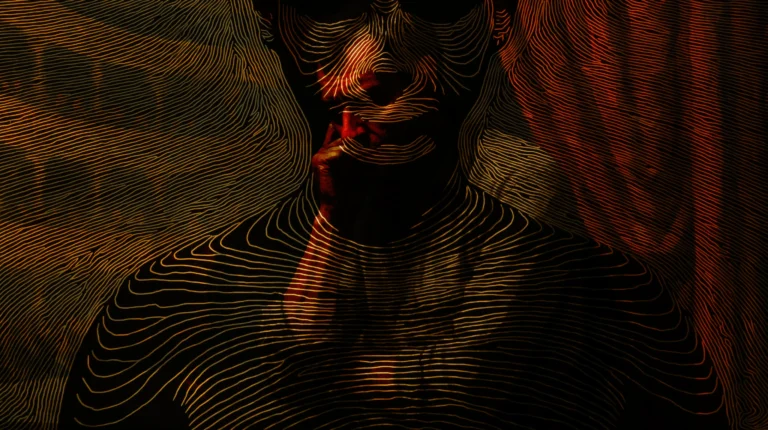Beyond the Veil of Negativity
Table of Contents
Chapter 1: The Burden
- Introduction
- Our Quest for Mental Freedom
Chapter 2: The Origins
- The Modern Scientific Perspective
- The Psychological Perspective
- The Philosophical Perspective
- The Spiritual and Esoteric Perspective
Chapter 3: The Consequences
- The Cycle of Anxiety
- Losing Authenticity
- The Power Others Gain Over Us
Chapter 4: Breaking the Chains
- Modern Scientific Solutions
- Psychological Solutions
- Philosophical Solutions
- Spiritual and Esoteric Solutions
Chapter 5: The Ancient Antidote
- Stoicism on Negative Thoughts
- The Dichotomy of Control
- Stoic Strategies for Negative Thoughts
- Stoicism on Fate’s Role
- The Power of Neutrality
Chapter 6: The Dawn of Freedom
- Rediscovering Authenticity
- Empowerment
- Flourishing Positive Emotions
Chapter 7: The Journey Ahead
- Ongoing Growth and Education
- A Call to Embrace Positive Thinking
- Concluding Remarks
Chapter 1:
The Burden
Introduction
Throughout human history, the weight of negative thoughts has influenced destinies. Be it at the level of individuals, communities, or civilizations, negative thinking has shaped actions, events, and outcomes. But what is it about this predisposition that makes it such an influential force in our lives?
Negative thinking, often arising from fears, insecurities, and past traumas, isn’t just a fleeting emotion or an occasional dark cloud. It’s a storm that, unchecked, can dominate the psyche, turning potential into paralysis, hope into despair, and present moments into incessant ruminations of the past or anxious anticipations of the future. It molds our perception, creating a filter that magnifies adversities and minimizes opportunities. As the French writer and philosopher, Albert Camus, aptly put it,
“The evil that is in the world always comes of ignorance, and good intentions may do as much harm as malevolence if they lack understanding.”
Camus’s insight beckons us to reflect deeper. It suggests that at the heart of our negative thinking lies not malice, but often a lack of understanding — a void filled by our fears and misconceptions. Just as our personal internal landscapes can become clouded by these misunderstood sentiments, the broader tapestry of human actions can be distorted by well-intentioned but misinformed decisions. This interplay between individual introspection and broader societal actions sets the stage for our exploration into the depths of negative thinking and its profound influence on our lives.
But if negativity has such profound impacts, why has it been an inseparable part of the human experience?
Our Quest for Mental Freedom
The desire for mental and emotional liberation isn’t a modern phenomenon. Ancient scriptures, philosophies, and oral traditions all contain wisdom about humanity’s quest to understand and transcend the limitations of the mind. As the renowned philosopher Søren Kierkegaard once said,
“Life can only be understood backward, but it must be lived forwards.”
And so, to free ourselves from the shackles of negative thinking, we must first understand its roots and reasons.
This book embarks on a journey through various lenses—scientific, psychological, philosophical, and spiritual—to demystify negative thinking. We will explore its evolutionary origins, delve deep into the psyche, contemplate age-old philosophical insights, and draw wisdom from spiritual teachings. And through this exploration, we aim not only to understand but to equip ourselves with tools and strategies to reclaim our mental freedom.
As we navigate through these pages, readers will be invited to reflect, introspect, and ultimately find ways to harness the mind’s immense potential. After all, the quest for mental freedom isn’t about escaping thoughts but mastering them. As the Sufi poet Rumi poetically expressed,
“Do not be a slave to your thoughts. Let them be the keys to the doors of the palace of life.”
Our voyage begins by delving into the origins of negative thinking—why are humans predisposed to pessimism, fear, and doubt? What do modern science, age-old philosophies, and spiritual traditions tell us about this enigmatic aspect of our being? Let’s set sail on this enlightening journey together.
Chapter 2:
The Origins
The Modern Scientific Perspective
Our ancestors, constantly exposed to life-threatening situations, depended on their instincts and perceptions for survival. A rustle in the bushes could be a predator or just the wind; however, assuming the worst often meant the difference between life and death. This “better safe than sorry” approach favored those who were more attuned to potential dangers, leading to an evolutionary bias towards pessimism. Charles Darwin’s insights on natural selection show that traits promoting survival, even if they veer towards negativity, would likely get passed down to future generations. This negative bias allowed our ancestors to anticipate and prepare for threats, ensuring our continued existence as a species.
The human brain, a marvel of nature, is also wired to prioritize negative experiences over positive ones. Neuroscientists suggest that negative events or emotions require more thinking and information processing than positive ones. The amygdala, a tiny almond-shaped structure in our brain, plays a pivotal role in this. It processes emotions like fear and triggers immediate reactions. Due to this “negativity bias,” negative experiences get stored in our long-term memory more quickly than positive ones. As psychologist Rick Hanson says,
“The brain is like Velcro for negative experiences but Teflon for positive ones.”
Evolutionarily, our brains are wired to hold onto negative experiences as a protective mechanism, making us hyper-aware of potential threats. While this once served our survival, in modern times, it often leads to undue stress and pessimism. Recognizing and accepting this inherent bias in our brain is the first step towards counteracting its effects, allowing us to nurture a more balanced and positive mindset.
The Psychological Perspective
Sigmund Freud, the father of psychoanalysis, delved deep into the human psyche’s intricacies. He proposed the existence of the Ego (our conscious self), Superego (our internal moral compass), and Id (our primal desires). The constant tension and conflict between these entities often push us towards negativity, guilt, and internal strife.
As Freud once stated,
“Unexpressed emotions will never die. They are buried alive and will come forth later in uglier ways.”
In the context of negative thinking, it means that when we ignore or push away negative thoughts without addressing their root causes, they don’t just disappear. Instead, they take root deep within our subconscious. Over time, these suppressed thoughts can manifest in detrimental ways such as heightened anxiety, chronic stress, or even physical ailments. Just as ignoring a wound can lead to infection, ignoring negative thoughts can cause them to intensify and emerge in more harmful forms.
Carl Jung, a student of Freud and a significant psychoanalyst in his own right, introduced the concept of the ‘Shadow Self‘—the part of our personality that contains all our repressed desires, weaknesses, and shortcomings. By failing to acknowledge and confront our shadow, we remain vulnerable to its influence. The “Collective Unconscious,” another of Jung’s profound concepts, speaks of shared memories and ideas that influence our thoughts and behaviors. Negative thinking, in part, stems from these deep-seated archetypes that reside within us. As Jung said,
“Everyone carries a shadow, and the less it is embodied in the individual’s conscious life, the blacker and denser it is. If it is repressed and isolated from consciousness, it never gets corrected.”
The Philosophical Perspective
Friedrich Nietzsche, with his profound insights into human nature, proposed the idea of the “Will to Power“—an intrinsic drive that pushes individuals towards dominance and achievement. However, when suppressed or channeled wrongly, this powerful drive can lead to pessimism, nihilism, and existential angst. Nietzsche believed that to overcome such negativities, one must embrace life’s inherent suffering and thus ascend to greater heights of self-realization. Nietzsche said,
“To live is to suffer, to survive is to find some meaning in the suffering.”
Negative thoughts, just like suffering, are an integral part of our lives. Just as we cannot entirely eliminate pain or adversity, we cannot wholly rid ourselves of negative thoughts. Instead of attempting to deny or suppress them, it’s more constructive to acknowledge their presence and seek understanding.
Arthur Schopenhauer, influenced by Eastern philosophies, viewed the world as driven by a blind and insatiable metaphysical will. This will, in its ceaseless striving, brings about suffering and negativity. Only through artistic expression, compassion, and asceticism can one momentarily transcend this inherent suffering of existence. As Schopenhauer aptly noted,
“A man can do what he wills, but not will what he wills.”
Negative thoughts often arise involuntarily. They are, in many ways, an intrinsic part of our mental landscape, influenced by our past experiences, biology, and environment. Just as we cannot always control our desires or feelings, we can’t simply will away negative thoughts. Acknowledging this reality is the first step in addressing and managing such thoughts.
Baruch Spinoza, a rationalist philosopher, posited that humans are prisoners to their emotions and desires. These emotions, unless understood and guided by reason, lead to bondage. True freedom and positivity, according to Spinoza, come from the intellectual love of God and nature, leading one to act out of reason rather than fleeting emotions. In his words,
“Emotion, which is suffering, ceases to be suffering as soon as we form a clear and precise picture of it.”
The Spiritual and Esoteric Perspective
Jalāl ad-Dīn Rumi, the great Sufi mystic, spoke of the inner battle that rages within every soul. This battle, between our lower desires and our higher aspirations, is the root of negative thinking. However, through love, dance, and union with the divine, one can transcend these negativities. As Rumi beautifully expressed,
“The wound is the place where the Light enters you.”
In essence, Rumi acknowledges that amidst the shadows of our psyche lies the potential for illumination. By confronting and understanding our internal struggles, we pave the way for wisdom and inner light to shine through.
Alan Watts, a philosopher who bridged Eastern and Western thought, believed that the root of negativity lies in the illusion of separateness. By perceiving ourselves as isolated entities, rather than parts of a cosmic whole, we give rise to anxiety, fear, and discontent. Watts encourages us to embrace the interconnectedness of existence, where every end is a new beginning. In the words of Watts,
“The more a thing tends to be permanent, the more it tends to be lifeless..”
In our quest for stability, we often shield ourselves from the very dynamism that defines life. Our world is in a constant state of flux, yet our minds grapple for enduring certainties. This attachment to permanence can be a breeding ground for negative thinking, for life rarely conforms to fixed expectations. By acknowledging life’s inherent impermanence, we can better navigate its ebb and flow, reducing the grip of negative thoughts and savoring the richness of each unfolding moment.
The ancient Hermetic teachings underscore the ebb and flow of life’s energies. At the heart of these teachings, the principle of rhythm, as encapsulated by the statement from The Kybalion:
“Everything flows, out and in; everything has its tides; all things rise and fall; the pendulum‑swing manifests in everything; the measure of the swing to the right is the measure of the swing to the left; rhythm compensates.”
This rhythmic balance speaks directly to our emotional and mental states. Just as happiness follows sadness, positivity can emerge from the depths of negativity. Recognizing this natural rhythm can liberate us from becoming ensnared in any single emotion or thought pattern.
Ancient Hermetic teachings, far from mere philosophical musings, present a stark reality about the universe and our place within it.
Strip away the ornate language, and here’s the unvarnished truth: life operates in cycles, and we’re not exempt. If you’re basking in joy today, brace for sorrow tomorrow. Feel mired in negativity now? It’s just a matter of time before positivity knocks on your door. This isn’t to be pessimistic, but to acknowledge the inherent rhythm of existence. To understand this is to be equipped for the inevitabilities of life. Emotions, thoughts, experiences—they’re all cyclical. The sooner you grasp this reality, the better equipped you’ll be to navigate the unpredictable tides of existence.
With these foundational insights laid out, we will explore the profound consequences of letting negative thinking take the reins of our lives. From individual struggles to societal implications, the weight of such thoughts is felt far and wide.
Chapter 3:
The Consequences
The Cycle of Anxiety
The perils of overthinking are akin to a snowball rolling downhill, gathering size and momentum with each rotation. A single negative thought, when brooded upon, can evolve into an overwhelming anxiety. This thought, when repeatedly reinforced, manifests in our actions. These actions, in turn, shape events that mirror our initial fears, forming a self-fulfilling prophecy. The French philosopher Jean-Jacques Rousseau once noted,
“We are always in a hurry to be happy… for when we have suffered a long time, we have great difficulty in believing in good fortune.”
This cycle of anxiety, created by overthinking, traps us in a loop, making it challenging to recognize and appreciate positive occurrences when they arise.
Losing Authenticity
Negativity, like an incessant drizzle, gradually wears away the rock of our authentic self. When we constantly indulge in negative patterns of thought, we begin to doubt our worth, abilities, and potential. This self-doubt muddies our perception of who we genuinely are and what we genuinely desire. Over time, we become shadows of ourselves, leading lives that echo societal expectations rather than our innermost aspirations. As Friedrich Nietzsche wisely pointed out,
“He who fights with monsters should be careful lest he thereby become a monster. And if you gaze long enough into an abyss, the abyss will gaze back into you.”
Negativity, left unchecked, erodes the pillars of our true self, leaving behind a facade built on fear and uncertainty.
The Power Others Gain Over Us
When we are ensnared in the web of negativity, our weakened emotional state becomes susceptible to external influences. Others can sense this vulnerability and, whether consciously or subconsciously, may exploit it. This manipulation manifests in various forms: peer pressure, toxic relationships, and even societal norms that dictate how we “should” live our lives.
This emotional slavery stems from our inner fears — of rejection, loneliness, or failure. These fears hold us hostage, making us surrender our power and autonomy to others. The great existentialist philosopher, Jean-Paul Sartre, famously said,
“Freedom is what you do with what’s been done to you.”
If we allow negativity to dictate our reactions to external influences, we forfeit our freedom and agency, letting others write the narratives of our lives.
Venture too deep into the vortex of negative thinking, and you initiate a dangerous cycle: a thought spirals into anxiety, which drives action, culminating in events that only further entrench your initial fears. This isn’t just a personal battle; it’s an open door for external forces. As you weaken, others gain the power to manipulate and control, ensnaring you in emotional chains born from your own fears.
In the unforgiving realm of negative thinking, understand this: every moment you surrender to these dark ruminations, you’re trading pieces of your authentic self, the one true asset you possess. Negative thoughts are not benign; they are insidious thieves. If left unchecked, they’ll strip you of your genuine identity, leaving behind an unrecognizable echo. By the end, when you seek your reflection, you might face a stranger. Guard your authenticity with your life; it’s the only one you have.
In navigating the labyrinth of our minds, recognizing the consequences of negative thought patterns is half the battle won. However, mere recognition is not enough. We must arm ourselves with tools, insights, and strategies to counter these detrimental effects. In the subsequent chapters, we shall delve into the myriad solutions presented by modern science, age-old philosophies, and spiritual traditions, equipping ourselves to break free from the chains of negativity and overthinking.
As Albert Einstein said,
“The world as we have created it is a process of our thinking. It cannot be changed without changing our thinking.”
Chapter 4:
Breaking the Chains
Modern Scientific Solutions
Contrary to once-popular belief, our brains are not rigid structures set in their ways by adulthood. Neuroplasticity, the brain’s ability to change and adapt, offers hope for anyone trapped in negative cycles of thinking. By actively engaging in positive habits and thought patterns, we can literally rewire our brains, creating neural pathways that support optimism and resilience. As Dr. Norman Doidge, an expert in neuroplasticity, proclaimed,
“Our brains are not hardwired; they are ‘soft-wired’ by experience.”
The ancient practices of mindfulness and meditation, now backed by modern science, have been proven to reduce stress, anxiety, and negative thoughts. By anchoring ourselves in the present moment, we break free from the chains of past regrets and future anxieties. A plethora of studies indicate that regular meditation not only calms the mind but also causes physiological changes, enhancing areas of the brain linked to self-awareness, empathy, and emotional regulation. As Jon Kabat-Zinn, a pioneer in the field of mindfulness-based stress reduction, said,
“You can’t stop the waves, but you can learn to surf.”
The truth is stark: if you’re serious about breaking the cycle of negativity, passive intentions won’t cut it. The brain’s adaptability is a double-edged sword; it can be your greatest ally or your gravest enemy. Harnessing neuroplasticity requires dedication. This means daily meditation, consistently anchoring yourself in the present, and actively choosing positive habits. It’s a relentless journey, not a weekend retreat. As the evidence stands, your brain will adapt, but only if you put in the consistent work. So, ask yourself: how much do you really want this change?
Psychological Solutions
Carl Jung believed that for holistic psychological health, one must undergo the process of individuation—integrating various aspects of the subconscious into the conscious. Central to this is acknowledging and understanding the ‘Shadow Self‘. Rather than suppressing or rejecting our darker tendencies, we should embrace and integrate them. This makes us complete, balanced individuals. As Jung himself stated,
“One does not become enlightened by imagining figures of light, but by making the darkness conscious.”
Let’s delve into the concept of the Shadow Self and its integration.
The Shadow Self, a term coined by the Swiss psychiatrist Carl Jung, refers to the unconscious part of our personality that contains traits, desires, and memories we’ve denied, suppressed, or disowned. It’s the reservoir of everything we don’t want to admit about ourselves. For example, if you’ve always seen yourself as a kind and patient person, your impatience and cruelty would be part of your shadow. These qualities aren’t necessarily negative; they might just not align with your conscious self-image.
Example: Imagine a diligent worker who prides himself on always meeting deadlines. One day, he’s overwhelmed with tasks and finds himself procrastinating. Instead of acknowledging this trait, he might project it onto a colleague, thinking, “John is so lazy and always delays his work,” even if that isn’t true. Here, the worker’s shadow manifests in seeing in others the trait he denies in himself.
Let’s explore the step-by-step process of integrating the Shadow.
1. Self-awareness and Reflection: Begin by acknowledging that you have a shadow self. Spend time in reflection or meditation, recalling situations where you’ve acted out of character or had strong reactions to someone else’s behavior.
2. Journaling: Write about these instances, trying to identify patterns or triggers. You might uncover feelings or behaviors you’ve been ignoring.
3. Dialogue with the Shadow: Engage in an internal dialogue. Ask your shadow why it behaves in certain ways. For example, if you find you’re often envious, ask this part of yourself why. The answers can often be surprising and illuminating.
4. Seek Feedback: Sometimes, friends, family, or colleagues can offer insights into behaviors or traits you might not recognize in yourself. However, approach this with caution and trust, as it can be challenging.
5. Professional Guidance: Consider working with a therapist or counselor skilled in Jungian analysis or shadow work. They can provide tools and safe environments to delve deep into these unconscious aspects.
6. Integration: Accepting and integrating doesn’t mean you act on every shadow impulse. It means recognizing it’s a part of you. For instance, if you find you have a quick temper buried deep down, acknowledging it can help you manage it better.
Remember, shadow integration is about wholeness. By recognizing, accepting, and working with your shadow, you can achieve a more complete and authentic self-awareness. It’s not about eradicating parts of yourself but understanding them. This process is challenging but can lead to profound personal growth and understanding.
Now, let’s dive into Freud’s psychoanalytic techniques: dream analysis and free association.
Freud’s psychoanalytic techniques, such as dream analysis and free association, provide tools to delve deep into our subconscious. By uncovering and addressing buried traumas, repressed emotions, and unresolved conflicts, we can achieve psychological liberation.
First, let’s discuss Freud’s approach to dream analysis.
Sigmund Freud considered dreams the “royal road to the unconscious.” He believed that our dreams were filled with symbols that, if correctly interpreted, could reveal insights into our desires, fears, and conflicts.
Example: Imagine a person who consistently dreams of missing a train. On the surface, it may seem straightforward, perhaps indicating a fear of being late. However, under Freudian analysis, this could symbolize missed opportunities in life or feelings of being left behind in some emotional capacity.
Let’s delve into the step-by-step process for dream analysis.
1. Recording: Immediately upon waking, record your dreams in detail, capturing as much as you remember.
2. Identifying Symbols: Look for recurring symbols or themes in your dreams. For example, water might symbolize emotions, and a locked door might represent blocked opportunities or repressed memories.
3. Interpretation: Reflect on what these symbols mean to you personally. While there are general interpretations, dream symbols are highly personal.
4. Connect with Reality: Consider events or feelings in your waking life that relate to the dream. Maybe you’ve been feeling stuck in your job, aligning with the “missed train” dream.
Now, let’s delve into Freud’s concept of Free Association.
Free association involves freely sharing thoughts, words, or memories without any censorship or filter. The aim is to uncover hidden thoughts and feelings that lie in the unconscious.
Example: A therapist might say the word “red.” A client might respond with “apple.” Following that, “hunger” might come to mind, then “loneliness,” eventually revealing a memory of a time they felt alone during lunch in school.
Now, let’s explore the step-by-step process for Free Association.
1. Safe Environment: It’s vital to ensure you’re in a safe, non-judgmental environment, preferably with a trained therapist.
2. Begin with a Word: Start with any word or thought.
3. Speak Freely: Share the next thing that comes to mind, regardless of how unrelated or nonsensical it may seem.
4. Avoid Censorship: It’s essential not to judge or filter your responses, even if they seem absurd or unrelated.
5. Connect the Dots: After the session, analyze the chain of words or thoughts. It might reveal hidden fears, desires, or memories.
The cathartic experience of confronting our innermost fears, under the guidance of a therapist, often leads to profound insights and emotional healing. As Freud said,
“The mind is like an iceberg, it floats with one-seventh of its bulk above water.”
Confronting the subconscious is not a mere stroll through the park; it’s a descent into the labyrinth of your psyche. Psychological healing isn’t just about recognizing your shadow self but actively integrating it. This integration is labor-intensive and often uncomfortable. Techniques like dream analysis and free association aren’t leisurely chats; they demand vulnerability and confronting deep-seated traumas. If you’re considering this path, brace yourself for challenging introspection. The results can be transformative, but only if you’re willing to face your innermost fears head-on. The question remains: are you prepared for the depths of this journey?
Philosophical Solutions
Friedrich Nietzsche believed in embracing life with all its ups and downs. To him, suffering was not a curse but a catalyst for profound growth and self-realization. By wholeheartedly affirming life, including its challenges, we can rise above negativity. As Nietzsche once penned,
“He who has a why to live can bear almost any how.”
Life, as Friedrich Nietzsche highlighted, is fraught with suffering; negative thinking is but a facet of this inevitable pain. Yet, the crucial question remains: Do you have a “why” strong enough to push past this suffering? Are you committed enough to anchor yourself to a purpose that can pull you out of the abyss of negativity?
Baruch Spinoza championed the power of reason over fleeting emotions. For Spinoza, true happiness and freedom come from understanding the nature of the universe and our place within it—an intellectual love of God. By aligning ourselves with this rational understanding, we can rise above the tumultuous sea of emotions, achieving a state of inner equilibrium and peace. As Spinoza once said,
“The highest activity a human being can attain is learning for understanding, because to understand is to be free.”
Spinoza urges a reliance on reason, challenging you: How consistently can you elevate reason above the transient whirlwind of emotions? In essence, confronting negativity requires not only understanding these philosophies but rigorously applying them. Evaluate your dedication, set your intention, and act upon it daily.
Spiritual and Esoteric Solutions
For the Sufi mystic Rumi, love was the answer to life’s most profound questions. In the embrace of divine love, all negativity dissolves. Rumi’s poems and teachings guide us on a journey from the confines of the ego to the vast expanse of love. Rumi urged,
“Do not be satisfied with the stories that come before you. Unfold your own myth.”
Embracing love, as Rumi emphasizes, is not just an idealistic pursuit but a demanding journey, requiring you to shatter the chains of ego. This is not about latching onto comforting tales handed down to you. It’s about forging your own path, confronting your own demons, and transcending them. Simply put: don’t just lean on ancient wisdom. Instead, challenge yourself, break free from preconceived narratives, and actively shape your own destiny. The choice is stark: remain a passive listener or become the author of your own story. Choose wisely.
Drawing from Eastern philosophies, Alan Watts taught the importance of living in the present. He believed that much of our negativity stems from clinging to attachments and harboring unrealistic expectations. By embracing the here and now, and letting go of our insistent need to control, we can find peace and joy in the simplest of moments. As Watts said,
“The art of living… is neither careless drifting on the one hand nor fearful clinging to the past on the other. It consists in being sensitive to each moment, in regarding it as utterly new and unique, in having the mind open and wholly receptive.”
The teachings of Alan Watts are clear: our incessant grip on the past and unrealistic anticipations for the future anchor us in negativity. If you’re seeking genuine peace and contentment, it won’t be found in holding on to attachments or trying to control every outcome. The solution? Live in the present. Understand that each moment is fleeting and irreplaceable. So, are you ready to let go of your crutches and truly experience life, or will you continue to let past regrets and future worries shackle your present? The decision is in your hands.
The ancient teachings of Hermeticism present a profound framework that reveals the interconnectedness of our thoughts and the world around us. Central to these teachings is the Law of Correspondence, encapsulated by the maxim,
“As above, so below.”
This principle suggests that patterns observed in our personal mental states can resonate and be reflected in the broader aspects of our lives. In essence, if we’re ensnared in negative thoughts, these patterns might manifest in our daily actions, relationships, and even larger life events. However, the reverse is also true; by transforming our inner thoughts, we can influence the bigger picture of our lives.
Another pivotal Hermetic tenet is the Law of Vibration, which conveys that everything, including our very thoughts, vibrates at a distinct frequency. Negative thoughts are akin to lower-frequency vibrations, whereas positive, empowering thoughts resonate at higher frequencies. Recognizing this, we are not mere victims of negativity but possess the power to change our vibrational frequency by consciously cultivating positive thoughts.
The Hermetic axiom,
“All is mind, the Universe is Mental,”
further underscores the primacy of our mental realm. Our perceived reality, with its highs and lows, joys and sorrows, is in many ways a reflection of our internal beliefs and thought patterns. If we persistently wallow in negative thinking, our reality inevitably becomes colored by that perspective. But with the understanding that our mind has the power to shape our reality, we can shift from a position of negativity to one of empowerment, balance, and harmony.”
The principles of Hermeticism aren’t just ancient sayings; they’re keys to understanding the universe’s framework. If you ignore these laws, you risk remaining out of sync with the cosmic order. Do you want a balanced mind and inner harmony? Start by understanding that everything is interconnected and that your mindset shapes your reality. Are you prepared to align with these universal truths, or will you dismiss them as mere ancient philosophies? Your mental harmony hinges on your choice.
Understanding the solutions and strategies available across diverse fields provides us with a comprehensive toolkit to combat negativity. In the journey ahead, we’ll delve deeper into practical exercises, rituals, and routines that can be incorporated into daily life, ensuring a positive, balanced, and fulfilling existence. As Albert Einstein said,
“In the middle of difficulty lies opportunity.”
Chapter 5:
The Ancient Antidote
Stoicism, an ancient Greek school of philosophy, has garnered renewed interest in modern times, especially in circles seeking peace and mental resilience. Founded in Athens by Zeno of Citium in the early 3rd century BCE, Stoicism provides a rich tapestry of insights on confronting and overcoming negative thinking.
Stoicism on Negative Thoughts
The Stoics believed that suffering comes not from the events in our lives but from our judgments about them. To the Stoics, negative emotions arise when we desire something out of our control. By focusing on what we can control—our thoughts, behaviors, and actions—and letting go of what we can’t, we find serenity. As the Stoic thinker Seneca once remarked,
“We suffer more often in imagination than in reality.”
The Dichotomy of Control
A foundational concept in Stoicism is the Dichotomy of Control. The Stoics identified that some things are within our control (our beliefs, judgments, desires, aversions) and others are not (other people’s beliefs, the past, the natural world). As the Stoic emperor-philosopher Marcus Aurelius once stated,
“You have power over your mind – not outside events. Realize this, and you will find strength.”
Stoic Strategies for Negative Thoughts
Now, let’s delve into the steps of Stoic techniques for combating negative thoughts.
1. Negative Visualization: This involves imagining worst-case scenarios. By doing so, we can appreciate what we have and mitigate the impact of negative events. As the Stoic philosopher Seneca once remarked,
“He robs present ills of their power who has perceived their coming beforehand.”
2. Premeditatio Malorum (The Pre-Meditation of Evils): By contemplating potential misfortunes, we become mentally prepared for them. This isn’t pessimism but a strengthening exercise. As the wise Seneca of Stoicism once noted,
“What is quite unlooked for is more crushing in its effect, and unexpectedness adds to the weight of a disaster. This is a reason for ensuring that nothing ever takes us by surprise. We should project our thoughts ahead of us at every turn and have in mind every possible eventuality instead of only the usual course of events.”
3. Practicing Asceticism: Periodically, Stoics would live with the bare minimum—simple food, clothes, etc., to remind themselves that happiness doesn’t derive from external comforts. In the words of Seneca,
“Set aside a certain number of days, during which you shall be content with the scantiest and cheapest fare, with coarse and rough dress, saying to yourself the while: ‘Is this the condition that I feared?'”
4. Journaling: Stoics believed in the power of writing to reflect on and transform one’s thoughts. Marcus Aurelius’ “Meditations” stands as a testament. As noted by him,
“The happiness of your life depends upon the quality of your thoughts: therefore, guard accordingly, and take care that you entertain no notions unsuitable to virtue and reasonable nature.”
Stoicism on Fate’s Role
The Stoics believed in accepting the will of the universe or fate, which they sometimes referred to as the “Logos.” This cosmic reason or order underpins everything, and resisting it is futile. In the words of Marcus Aurelius,
“Accept whatever comes to you woven in the pattern of your destiny, for what could more aptly fit your needs?”
The Power of Neutrality
Marcus Aurelius, a central figure in Stoic philosophy, once profoundly stated,
“We have the power to hold no opinion about a thing and to not let it upset our state of mind–for things have no natural power to shape our judgment.”
This notion is emblematic of the Stoic attitude towards external events and their potential influence on our inner state.
The Stoics recognized that while we can’t dictate the events that transpire around us, we can control our reactions, perceptions, and judgments. In essence, they urge us not to be passive observers but discerning participants in our lives.
Living in an era where information and stimuli continuously bombard us, the Stoic teachings on the power of neutrality become more relevant than ever. The quote from Marcus Aurelius starts with an intriguing premise – we have the power to hold no opinion about something. This might appear counter-intuitive, particularly in a world where everyone seems compelled to have an opinion on every matter.
However, the power of neutrality stems from the wisdom that not all things warrant our emotional or cognitive energy. There’s a serenity that comes with the conscious choice to reserve judgment. It enables us to view the world and its occurrences with a clear lens, unobstructed by the fog of bias or undue emotional investment. By abstaining from immediate judgment, we grant ourselves the space to assess situations with clarity and objectivity. This approach lessens the likelihood of reacting impulsively or making decisions that might not serve our higher self.
Conclusively, as we traverse the unpredictability of life, the Stoic perspective remains ever relevant. By understanding and embracing the Stoic principles, especially those surrounding judgment and neutrality, we equip ourselves with tools that not only combat negative thinking but also foster a profound inner tranquility. In the succinct words of Epictetus,
“It’s not what happens to you, but how you react to it that matters.”
And sometimes, the most potent reaction might just be the conscious decision not to react at all.
Chapter 6:
The Dawn of Freedom
Rediscovering Authenticity
When the veil of negativity lifts, the first thing many of us discover is a clearer sense of self. It’s as if we’ve been looking at our reflection through a fogged mirror for years, and now, suddenly, the mist has cleared. Authenticity is about embracing our true essence, stripped of societal expectations, self-doubts, and fear-driven pretensions. As Oscar Wilde fittingly said,
“Be yourself; everyone else is already taken.”
By liberating ourselves from negative thought patterns, we allow our genuine self to emerge, vibrant and unashamed, basking in the light of self-acceptance and self-love.
Empowerment
Overcoming negativity doesn’t just change our internal world; it revolutionizes our external reality as well. No longer are we puppets dancing to the tunes of external influences, be they individuals, societal norms, or perceived obligations. We reclaim the reins of our lives. This newfound empowerment is intoxicating. We become architects of our fate, understanding that while we might not control every event, we control our reactions to them. As Eleanor Roosevelt astutely observed,
“No one can make you feel inferior without your consent.”
When we dismantle the chains of negativity, we revoke that consent, asserting our rightful place in the world.
Flourishing Positive Emotions
The void left by the absence of negative thoughts and feelings isn’t merely a void—it’s quickly filled by a surge of positive emotions. Like plants stretching towards sunlight after a prolonged night, joy, love, and peace flourish in the wake of negativity’s departure. The world appears brighter, interactions seem richer, and moments, no matter how mundane, brim with significance. Rumi, in his boundless wisdom, described this transformation:
“With life as short as a half-taken breath, don’t plant anything but love.”
By overcoming our negative wounds, we become conduits for these radiant emotions, transforming not just our personal experiences but also the lives of those we touch.
The journey from the depths of negativity to the zenith of freedom is arduous, but every step is worth the struggle. The metamorphosis promises not just an escape from mental turmoil, but the dawn of a life defined by authenticity, empowerment, and an abundance of joy. This isn’t merely about avoiding suffering; it’s about embracing a life of profound significance and boundless potential. The dawn awaits.
Chapter 7:
The Journey Ahead
Ongoing Growth and Education
Every journey, no matter how transformative, isn’t a destination but a continual process. As we move beyond the confines of negativity, the path ahead beckons with promises of uncharted experiences, lessons, and insights. Growth isn’t linear; there will be moments of regression, times when old patterns resurface. Yet, armed with the tools and knowledge we’ve acquired, these instances become not setbacks, but opportunities—chances to apply what we’ve learned, to deepen our understanding, and to further fortify our mental resilience.
One must remember, the beauty of growth lies not in its endpoint but in its journey. As John Dewey, the esteemed philosopher and educator, once said,
“Education is not preparation for life; education is life itself.”
Similarly, our pursuit of positivity and mental freedom isn’t a task to be completed but a lifelong commitment to learning and self-improvement.
A Call to Embrace Positive Thinking
As we stand at this juncture, looking back at the valleys of negativity we’ve crossed and gazing forward at the vast horizon of possibilities, there is a clarion call that resonates within. Embrace positive thinking. It’s more than just an optimistic attitude; it’s a way of life. A perspective that doesn’t ignore life’s challenges but chooses to see them as stepping stones rather than stumbling blocks.
The transformative power of positive thinking isn’t mere conjecture—it’s backed by countless stories of individuals who’ve changed their lives, scientific studies that vouch for its benefits, and age-old wisdom from various cultures and traditions. As the mystic Rumi beautifully encapsulated,
“Let yourself be silently drawn by the strange pull of what you really love. It will not lead you astray.”
Concluding Remarks
Life, in its complex tapestry of highs and lows, presents a common challenge to us all: the innate pull towards negative thinking. Science, with its meticulous observations, validates this inclination; psychology offers similar insights, probing the depths of our subconscious. The philosophical musings of thinkers like Arthur Schopenhauer echo these sentiments, painting life with shades of suffering.
Yet, amidst this seemingly grim reality, lies a profound wisdom. We aren’t alone in this vast expanse of the human experience. Schopenhauer’s acknowledgment of shared suffering serves as a gentle reminder: our struggles, though uniquely experienced, are universally felt. This, in itself, should be a catalyst for compassion—firstly, to oneself and then radiating outwards to others.
Life’s ebb and flow, its cyclical nature of joy and sorrow, is inevitable. To expect a perpetually sunny horizon is to set oneself up for disappointment. But herein lies the true lesson: in accepting life’s inherent suffering, we can find a deeper resilience. As the shadows of negativity loom, the power of mental fortitude and the love of one’s fate become our guiding lights.
Face your negative thoughts head-on; don’t shy away from them. After all, they are a part of you. Embrace every facet of your being, breathe through the challenges, and remember: while negativity may be a persistent visitor, it doesn’t have to be a permanent resident. As you close this book, carry forward the spirit of resilience, compassion, and the audacity to love every twist and turn of your unique journey.
Let’s conclude our journey with a timeless tale that speaks volumes about life’s impermanence. Once, in an ancient kingdom, there reigned a king known for his insatiable quest for wisdom. One day, he summoned his wisest minister, a man of profound depth, with a unique request. He said, “I want you to inscribe something on my ring. When I am engulfed in sorrow and read it, I should find joy. And when I am in the throes of happiness and glance at it, it should bring me back to humility.”
The sagacious minister contemplated deeply, spending an entire night in thoughtful meditation. The next morning, he handed the king a beautifully engraved ring. As the king read the inscription, a gentle smile spread across his face. On that ring was etched a simple yet profound message:
“This too shall pass.”
Echoes of Wisdom:
From Darkness to Dawn
In the vast realm of thought where shadows play,
Where Stoics stand firm, and Rumi lights the way,
Negative whispers, like tempests, may roar,
Yet ancient wisdoms offer so much more.
From Schopenhauer’s dance with life’s ebb and flow,
To Jung’s deep dives where dark shadows grow,
Freud delved in dreams, unlocking the mind,
While Watts urged us to live unconfined.
Hermetic truths say as below, so above,
While Nietzsche queries the ‘why’ we all love.
Through the cycles of joy, sorrow, and mirth,
Spinoza teaches reason’s inherent worth.
In this dance of thoughts, both dark and light,
Remember, dear reader, to hold your core tight.
For in every challenge, in every test,
Lie lessons of love, growth, and the quest.
Though negative thoughts may cloud the way,
With resilience and love, night turns to day.
As we journey, hand in hand, past and through,
Remember always: “This too shall pass” too.







